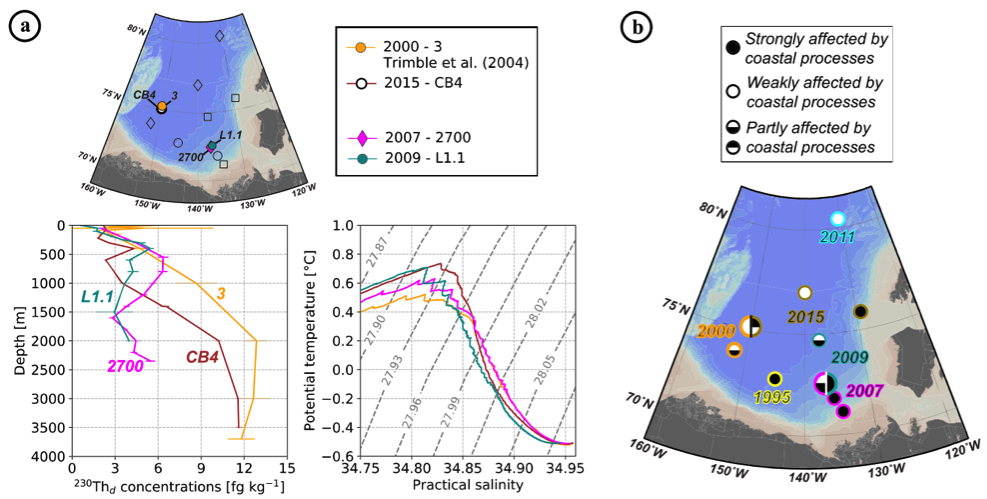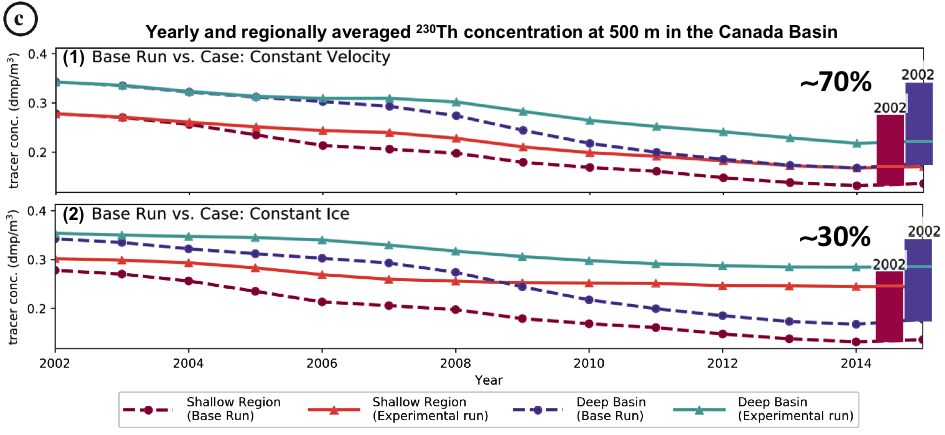Particulate fluxes and circulation in a changing Arctic Ocean: tracer data and modeling
A complete review of published and new water column profiles of thorium-230 (230Th) and protactinium-231 (231Pa) concentrations and neodymium (Nd) isotopic compositions collected in the Amerasian Basin of the Arctic Ocean between 1983 and 2015 was performed by Grenier and co-workers (2019, see reference below). This review allowed them to identify regional and temporal variability of geochemical and physical oceanic properties, among which was a notable regional decrease in 230Th and 231Pa concentrations with time. They associated this decrease to an increase in the last decades of:
- lateral and vertical particulate fluxes, resulting from enhanced sediment resuspension and productivity, respectively;
- ocean mixing;
in response to increasing summer retreat of sea ice and enhanced coastal erosion.
These hypotheses were corroborated and complemented by a companion modeling paper, in which Yu and co-workers (2020) performed the first modeling of 230Th in the Arctic Ocean by coupling a physical model (NEMO configuration ANHA4) to a chemical scavenging one (230Th model). Their approach enabled them to characterize the relative contribution of the parameters – enhancement of particle fluxes vs. enhancement of ocean mesoscale mixing and advection– driving the modeled 230Th concentration decrease between 2002 and 2015.


(c) From Yu et al. (2020): modeled contribution of sea ice retreat and ocean mixing increase to 230Th decrease. Time series of yearly and regionally averaged 230Th concentrations at 500 m in the Canada Basin. (1) Base Run (variable ocean flow and sea ice) versus Exp. 1, in which the ocean flow repeats 2002 and thus does not change with time. (2) Base Run versus Exp.2, where the sea ice is held at the 2002 level. These two comparisons show that the particle flux increase –defined as fully dependant on sea ice retreat– accounts for ~70% of the modeled 230Th concentration decrease since 2002, while the remaining ~30% decrease results from increases in ocean mesoscale mixing and advection.
References:
Grenier, M., François, R., Soon, M., Rutgers van der Loeff, M., Yu, X., Valk, O., Not, C., S. Bradley Moran, S. B., Edwards, R. L., Lu, Y., Lepore, K., & Allen, S. E. (2019). Changes in Circulation and Particle Scavenging in the Amerasian Basin of the Arctic Ocean over the Last Three Decades Inferred from the Water Column Distribution of Geochemical Tracers. Journal of Geophysical Research: Oceans, 124(12), 9338–9363. DOI: https://doi.org/10.1029/2019JC015265
Yu, X., Allen, S. E., François, R., Grenier, M., Myers, P. G., & Hu, X. (2020). Modeling Dissolved and Particulate Th in the Canada Basin: Implications for Recent Changes in Particle Flux and Intermediate Circulation. Journal of Geophysical Research: Oceans, 125(2). DOI: https://doi.org/10.1029/2019JC015640
McLaughlin, F. A., Carmack, E. C., Williams, W. J., Zimmermann, S., Shimada, K., & Itoh, M. (2009). Joint effects of boundary currents and thermohaline intrusions on the warming of Atlantic water in the Canada Basin, 1993–2007. Journal of Geophysical Research, 114, C00A12. DOI: https://doi.org/10.1029/2008JC005001
